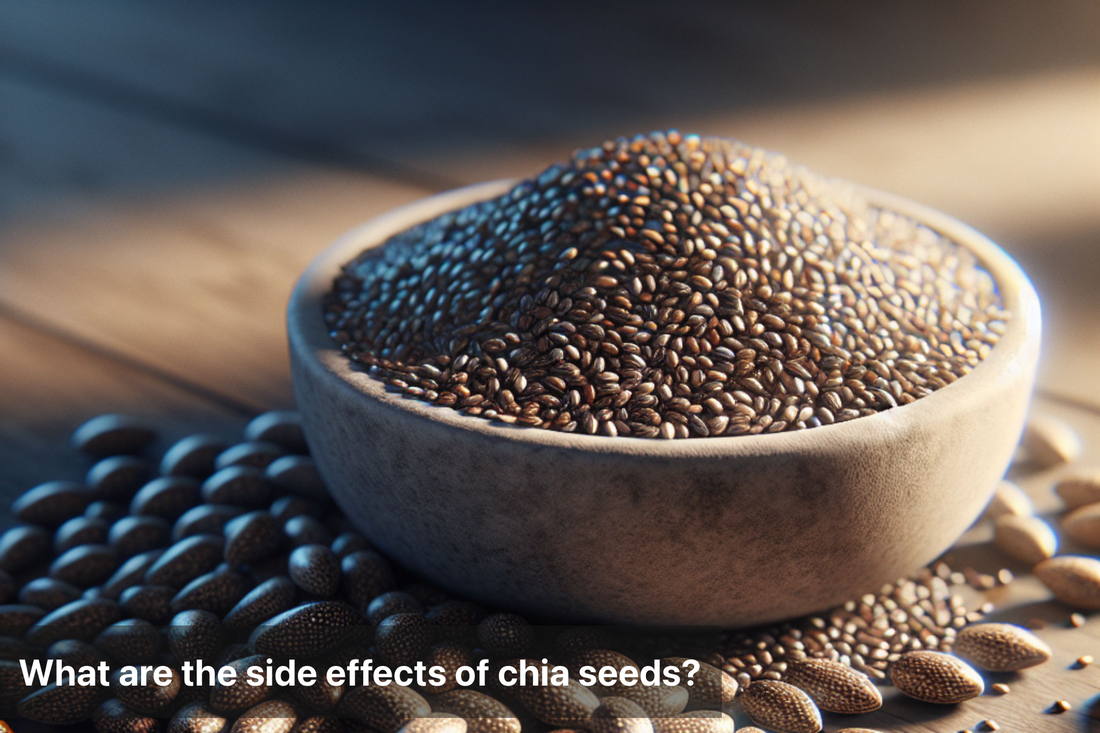
What are the side effects of chia seeds?
Share
Chia seeds have exploded in popularity over the last decade, hailed as a superfood rich in omega-3 fatty acids, fiber, protein, and antioxidants. From smoothies and puddings to salads and overnight oats, they’ve become a pantry staple in many health-focused kitchens. But like any food, especially those consumed in concentrated amounts, chia seeds come with potential side effects when overused or not consumed properly. So, what are the side effects of chia seeds, and how can you enjoy their benefits while avoiding discomfort?
In this blog, we explore the lesser-known risks of chia seeds, who should consume them cautiously, proper preparation methods, and how they compare to other nutrient-dense seeds.
Nutritional Snapshot of Chia Seeds (Per 28g or ~2 tbsp)
Calories: ~138 kcal
Fiber: 10–11g
Protein: 4.7g
Fat: 9g (mostly omega-3 ALA)
Carbohydrates: 12g (mostly fiber)
Calcium: 18% of RDA
Magnesium: 30% of RDA
Iron: 12% of RDA
Clearly, chia seeds are rich in key nutrients. But overconsumption or improper use can lead to several issues.
Common Side Effects of Chia Seeds
1. Digestive Problems (Bloating, Gas, Constipation)
Chia seeds are extremely high in fiber. While this is usually beneficial for digestion, consuming too much—especially without enough water—can lead to bloating, stomach cramps, and constipation. This is particularly common when people add dry chia seeds directly to foods without soaking them first.
2. Choking Hazard
Chia seeds can absorb up to 10–12 times their weight in water and form a gel-like texture. If eaten dry and followed by water, they can expand in the throat and potentially cause choking. This is rare but has been reported, especially in people with swallowing issues.
3. Blood Thinning Risk
Due to their high omega-3 content, chia seeds may have mild blood-thinning properties. This can be problematic for people on blood-thinning medications or those with bleeding disorders. It’s advisable to consult a doctor before consuming large amounts regularly.
4. Food Allergy (Though Rare)
Though uncommon, some people may have allergic reactions to chia seeds. Symptoms can include rashes, vomiting, diarrhea, or even breathing difficulties. Anyone trying chia seeds for the first time should begin with small amounts.
5. Interference with Blood Sugar Control
While chia seeds may help stabilize blood sugar levels in most people, consuming too much fiber at once can sometimes lead to erratic blood sugar or digestive stress, particularly in individuals with sensitive guts or on medication for diabetes.
6. May Affect Mineral Absorption
Chia seeds contain phytic acid, an antinutrient that can bind minerals like iron, zinc, and calcium, reducing their absorption in the body when eaten in very large amounts. This is rarely a concern for those with a balanced diet, but it’s something to be aware of.
Who Should Be Cautious?
People with digestive issues like IBS or sensitive stomachs
Individuals on blood thinners or anti-coagulants
Those with low blood pressure or hypotension
People with swallowing difficulties (e.g., elderly or children)
Anyone with known seed allergies
Individuals taking medication for diabetes or cholesterol (consult your doctor)
How Much Chia Is Safe Per Day?
Most nutritionists recommend 1–2 tablespoons (15–30g) of chia seeds per day. This provides enough fiber, protein, and omega-3s without overloading your digestive system or interfering with nutrient absorption. Always increase intake gradually and drink plenty of water.
Safe Ways to Eat Chia Seeds
Soak before eating: Combine chia with water or milk and let it sit for at least 15–30 minutes to allow it to expand safely
Blend in smoothies: Add soaked chia seeds to smoothies to enhance texture and nutrition
Use in baking or porridges: Add to muffins, breads, oatmeal, or overnight oats
Hydrate well: Pair chia with fluids to avoid fiber-related issues
Try chia pudding: A popular and safe way to enjoy chia is by soaking it overnight with almond milk, vanilla, and fruits
Chia Seeds vs Other Seeds – Pros and Cons
Seed Type |
Key Nutrients |
Common Side Effects |
Best Use |
|---|---|---|---|
Chia Seeds |
Omega-3s, Fiber, Protein |
Bloating, choking risk, mild allergy |
Soaked in smoothies, puddings |
Flaxseeds |
Omega-3s, Lignans |
Can block absorption if not ground |
Ground in smoothies, baking |
Pumpkin Seeds |
Zinc, Magnesium, Iron |
High calories if overeaten |
Roasted snacks, trail mixes |
Sunflower Seeds |
Vitamin E, Selenium |
May trigger allergies |
Salads, baking, energy bars |
Basil Seeds |
Cooling effect, Fiber |
Similar to chia, but less known |
Traditional drinks, falooda |
Tips to Minimize Chia Side Effects
Start small: Begin with 1 tsp a day and gradually increase
Always soak or hydrate: Never eat large quantities of dry chia seeds
Balance fiber intake: Don’t pair chia with too many other high-fiber foods at once
Drink enough water: Fiber needs hydration to work properly
Store properly: Keep in an airtight container away from sunlight to avoid rancidity
Combine with probiotics: If digestive upset occurs, pair chia with curd or yogurt
Chia Seeds and Pregnancy: Are They Safe?
In general, chia seeds are considered safe during pregnancy due to their iron, calcium, and omega-3 content. However, expecting mothers should:
Stick to small daily amounts (1–1.5 tbsp)
Avoid dry consumption
Ensure they are well-hydrated when consuming chia
Always consult a healthcare provider if unsure
Summary
Chia seeds are a nutritional powerhouse—but too much of a good thing can sometimes backfire. While they offer a wide array of health benefits, from fiber to omega-3s, they may also cause side effects like bloating, gas, or choking if consumed dry or in large amounts.
By understanding the correct portion size, soaking methods, and personal health considerations, you can enjoy chia seeds safely and reap their full benefits. Moderation, hydration, and preparation are the keys to making this super-seed work for your body—not against it.






